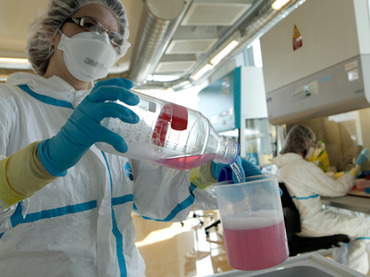TB
continued: Drug-resistant strain of deadly disease alarms doctors
worldwide
The
world is in the middle of a tuberculosis pandemic, scientists say.
What was once a disease of undeveloped nations has raced across
continents, with thousands of cases in Asia and Europe. The disease
may infect up to two million people by 2015.
RT,
30
August, 2012
An
extensive international study published by the Lancet medical journal
shows that the illness, once thought to be the stuff of books by the
likes of Charles Dickens, is making a quiet comeback. Cases of
tuberculosis in Africa, Asia, Europe and Latin America are on the
rise, and many of them are of a strain resistant to vaccination.
The
study examines two types of tuberculosis: Multi drug-resistant (MDR)
and extensively drug-resistant (XDR), both of which are far more
widespread than previously believed, experts claim.
Tuberculosis
is a bacterial infection that destroys patients’ lung tissue. The
disease is then spread through the air through coughing and sneezing.
Anyone with active TB may infect an additional 10 to 15 people a
year, experts say.
MDR
tuberculosis is resistant to at least two first-line drugs –
Isoniazid and Rifampicin – used as primary treatment in confirmed
cases of the disease. XDR is resistant not only to these two, but
also to an antibiotic used as second-line drug.
"Most
international recommendations for TB control have been developed for
MDR-TB prevalence of up to around five percent. Yet now we face
prevalence up to ten times higher in some places, where almost half
of the patients … are transmitting MDR strains," Sven Hoffner
of the Swedish Institute for Communicable Disease Control wrote in a
commentary on the study.
Afghan
women look on as a child lies on a bed in a tuberculosis section of
the main hospital in Herat (AFP Photo / Aref Karimi)
Presently,
most seem to worry about diseases of the exotic type: Bird or swine
flu, or West Nile virus generally tend to dominate headlines in the
West. But scientists are warning that the world is in the midst of a
tuberculosis pandemic.
In
2010, 8.8 million people were infected with TB, with 1.4 million
dying from the disease.Treating TB is an arduous process. Patients
often require a multitude of drugs, with treatment lasting for up to
six months. Many patients fail to complete the process correctly –
which researchers believe is a factor in the increase of cases of
drug-resistant forms of TB.
Drug-resistant
TB is not only more difficult to treat, but also more expensive.
Chief Scientific Officer Tom Evans of Aeras, a non-profit group
working on development of new vaccines, told Reuters that “without
a robust pipeline of new drugs to stay one step ahead, it will be
nearly impossible to treat our way out of this epidemic.”
But the
treatment, Evans said, is “limited, expensive, and toxic.”
Photomicrograph
of a sputum sample containing Mycobacterium tuberculosis. Courtesy:
Centers for Disease Control and Prevention's Public Health Image
Library
In
the US, a case of MDR tuberculosis can cost up to $250,000 per
patient. In less developed countries, such costs will likely be
unmanageable for patients and healthcare systems.
According
to the study, TB strains resistant to any second-line drugs were
found in nearly 44 percent of patients: From 33 percent of cases in
Thailand to 62 percent of cases in Latvia.
XDR
tuberculosis was found in 6.7 per cent of all patients in the study.
Rates in South Korea and Russia, at 15.2 and 11.3 percent
respectively, were more than twice the global estimate made by the
World Health Organization.
The
highest prevalence of MDR tuberculosis documented to date – 47.8
percent – was reported in 2011 in Minsk, Belarus, according to the
Lancet study.
Though
infection rates vary greatly between countries, scientists warn
against stereotyping the disease as an issues solely of poorer, less
developed nations: “MDR tuberculosis is not an issue isolated in
one city or country, but reflects a wider public health threat
resulting from severely resistant forms of M tuberculosis. To
adequately address MDR tuberculosis, more solid epidemiological
information is needed to increase overall understanding of disease
development and transmission,” Sven Hoffner wrote in Lancet.






No comments:
Post a Comment
Note: only a member of this blog may post a comment.